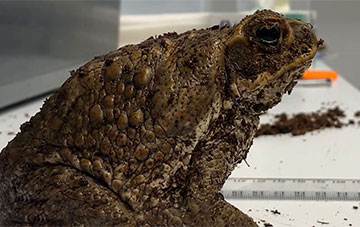
The researchers used a system that integrated photonic radar with lidar to accurately detect the respiratory patterns of a cane toad. [Image: S. Zentilomo / University of Sydney]
Tracking vital signs is a clinical necessity in settings such as hospitals and aged-care facilities. Usually it’s accomplished with contact-based devices, including pulse oximeters and smart watches. However, these systems can be inconvenient and uncomfortable for round-the-clock monitoring, and they are unsuitable for patients such as burn victims or infants without sufficient skin area. Camera imaging presents a noncontact option, but that method is subject to variations in ambient light conditions and skin color and raises privacy concerns.
Now scientists in Australia say they have developed a system that combines photonic radar and lidar to enable remote, highly precise vital-sign monitoring (Nat. Photon., doi: 10.1038/s41566-023-01245-6). According to a press release accompanying the research, this hybrid arrangement, which leverages the advantages of each approach, could provide a platform for a cost-effective, high-resolution noncontact vital-sign detection system.
Making photonic radar
Radar using RF waves can remotely access a patient’s vital signs, making it a potential solution for contactless monitoring. However, traditional electronic radars have a narrow bandwidth and reduced range resolution, so they can’t distinguish between targets placed close together and can’t detect delicate human vital signs, such as respiration.
A schematic of the photonic-radar setup prototyped in the work. OS, optical switch; AOFS, acousto-optical frequency shifter; EDFA, erbium-doped fiber amplifier; PD, photodetector; DSP, digital signal processor; EOM; electro-optical modulator; TX, transmitter; RX, receiver; AP, access point. [Image: Z. Zhang et al., Nat. Photon., doi: 10.1038/s41566-023-01245-6 (2023); CC-BY 4.0] [Enlarge image]
To get past these difficulties, the researchers prototyped a system in which the radar signal is created not electronically, but photonically. The photonic-radar system begins with a laser source that sends a seed pulse into a fiber loop that includes an acousto-optical frequency shifter. On each 162-ns round trip through the loop, the pulse frequency is shifted by 100 MHz. An erbium-doped fiber amplifier embedded in the loop keeps the pulse power alive for multiple circulations.
The result, after 250 round trips in the fiber loop, is a stepped-frequency (SF) optical signal with a broad bandwidth (up to 30 MHz) and high time−frequency linearity—both essential, the authors write, for accuracy and precise range resolution in a vital-signs radar sensing setup. The SF signal, carried by fiber optics, is converted to the RF domain by heterodyne mixing with a reference laser, and transmitted to the target with a transmitting antenna. The reflected radar signal is then picked up by a receiving antenna, converted back to the optical domain by an electro-optical modulator, and logged with a photodetector.
A lidar extra
In addition to the advantages in creating radar signals for vital-sign detection, the authors point out that, because the microwave signal is originally created in the optical domain, it can do double-duty for lidar sensing of vital signs. This is accomplished by simply tapping part of the SF optical signal directly, rather than sending it for conversion to the RF domain.
The ability to do lidar and radar sensing from the same source could offer a considerable plus, the researchers believe.
The ability to do lidar and radar sensing from the same source could offer a considerable plus, the researchers believe. That’s because while lidar on its own provides improved range and resolution, and thus can pick up delicate vital-sign activity beyond the reach of radar, it has a limited ability to penetrate objects such as clothing. Integrating both methods allowed the team to take advantage of the complementary features of the two approaches, to improve the overall system’s sensing accuracy and resilience.
“This hybrid approach delivered a vital-sign detection system with a resolution down to six millimeters with micrometer-level accuracy,” said lead author Ziqian Zhang, University of Sydney, in a press release. “This is suitable for clinical environments.”
Passing the toad test
In a test, the system accurately distinguished the breathing patterns of two closely located human respiration simulators—set about 10 cm apart—in real time. The system was sensitive enough to detect irregular respiration from subtle, millimeter-level movements in the devices, which the researchers say proves its ability to accurately correctly identify or even predict respiratory abnormalities linked to many medical conditions.
The team then turned the setup to the buccal region (roughly speaking, the cheek) of a cane toad as a human proxy. The region has a radar cross section smaller than that of the human chest, making the experiment more challenging than human trials. The data extracted from the photonic radar produced an accurate trace of the toad’s buccal movement, which had a displacement of about 5 mm. The scientists confirmed that the lidar system, with a total synthesized bandwidth of 25 GHz, was likewise sufficient to catch the toad’s respiration, illustrating the success of the complementary radar–lidar approach.
A schematic of the photonic-radar setup prototyped in the work. OS, optical switch; AOFS, acousto-optical frequency shifter; EDFA, erbium-doped fiber amplifier; PD, photodetector; DSP, digital signal processor; EOM; electro-optical modulator; TX, transmitter; RX, receiver; AP, access point. [Image: Z. Zhang et al., Nat. Photon., doi: 10.1038/s41566-023-01245-6 (2023); CC-BY 4.0] [Enlarge image]
Detection from a distance
The authors ultimately envision their system being used in a clinical setting for continuous, noncontact vital-sign monitoring. They write that, since the signals can be piped through low-loss optical fiber to multiple sensing access points, the setup could be used to noninvasively track multiple targets from one centralized photonics-assisted radar platform. This approach, the researchers note, could also allow uninterrupted monitoring of uncooperative and back- or side-facing targets, unlike the use of a single radar access point.
According to Zhang, the next step is to miniaturize the system and integrate it into photonic chips for use in portable, handheld devices. The team is also looking at the possibility of tests of the system on human subjects, and on extending it for potential use with moving subjects in settings like aged-care facilities.



